The construction of a steel wall on the Polish-Belarusian border is not just a physical barrier but a threat to the integrity of the Białowieża Forest, a UNESCO World Heritage Site. This unique ecosystem is under siege, and the suffering of migrants, violently turned back by both countries, is only exacerbating the crisis. The forest is now a battleground, pitting national security against preserving biodiversity.
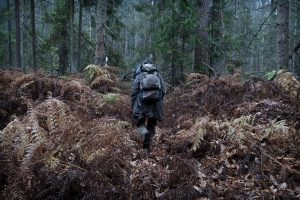 In July 2022, at a UN round table, the Belarussian representative alerted to the construction of the just-completed wall in the Białowieża Forest on the Polish-Belarussian border. In its 2022 national review report on implementing the 2030 Sustainable Development Goals, Minsk points out that the wall “raises the question of preserving this relict forest, its biological diversity and established ecosystem.”
In July 2022, at a UN round table, the Belarussian representative alerted to the construction of the just-completed wall in the Białowieża Forest on the Polish-Belarussian border. In its 2022 national review report on implementing the 2030 Sustainable Development Goals, Minsk points out that the wall “raises the question of preserving this relict forest, its biological diversity and established ecosystem.”
The Białowieża Forest, Europe’s oldest primary forest, is a sanctuary of unparalleled biodiversity. Its Polish part was designated as a UNESCO World Heritage Site in 1979, and its Belarusian part in 1992. The forest(1), spanning 141,885 hectares, is home to Europe’s largest population of bison, 180 bird species, and 59 mammal species.
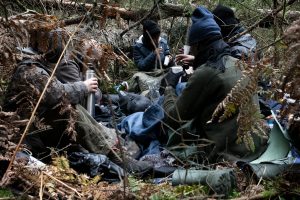
Photo: Hanna Jarzabek, 2022.
Since mid-2021, however, the puszcza has been at the center of a humanitarian crisis as migrants from (among other places) Iraq, Syria, Afghanistan, Egypt, Palestine, Yemen, Congo, and Cameroon attempt to cross the Polish-Belarusian border. Initially, the arrival of these migrants in Belarus was encouraged by Minsk (with the granting of tourist visas), which was denounced by the Polish government as an instrument of "hybrid warfare." By mid-November 2021, just a few months after the start of this humanitarian crisis, the NGO Grupa Granica (Border Group) had received calls from around 5,370 people at the border, and Fundacja Ocalenie (Relief/Rescue Foundation) had received 2,300. In 2021, the Polish border guards recorded 39,670 attempts to cross the border illegally (compared with 129 in 2020)(2).
Since the end of the communist regime, the puszcza has been the focus of protests on several occasions, including those against the extension of the nature park in 2000, rallies by the far-right Obóz Narodowo-Radykalny (National-Radical Camp) movement, and protests against the felling of spruce trees to combat the spread of bark beetles in 2017. As a result, the puszcza is no longer at the border but, on the contrary, at the center of conflicts over the redefinition of territory(3). The construction of a border wall cutting the puszcza in two can be seen as a last-ditch attempt to restore order.
Is building a wall a matter of national security?
In September 2021, the Polish government announced the construction of a steel wall 187km long and 5 to 6 meters high on the part of the Polish-Belarussian border (400km long). In May 2022, in a letter to the European Parliament, European Commission President Ursula von der Leyen reiterated that the construction of border infrastructure was the responsibility of the Member States but that the Commission supported the “sophistication” of border management. The environmental implications of such infrastructure are considered secondary to the defense of the public interest. Labeling a project as a matter of “national security” can override current environmental regulation(4).
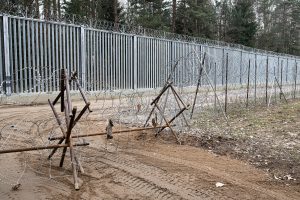
Photo : Hanna Jarzabek, 2024.
The Polish government has justified these environmental law violations by the need to maintain a secure border. A “secure” border is not crossed by illegal immigrants, who are perceived as a danger to the Polish population. The protection of the most “vulnerable” (or even “desirable,” i.e., women, children, and Christians) migrants serves to legitimize a border policy based on categorizing them.
The definition of a “secure” border varies between those who oppose mobility (of specific categories of migrants) and those who defend it. For example, activists who help migrants define a “safe” border as one “where no one dies” (“Bezpieczna granica to taka, na której nikt nie umiera”). With the construction of the wall in the name of national security, the border becomes a space that is both controlled (with the militarisation of the Białowieża Forest, including parts of the puszcza that previously had no human presence) and on the move (with people and animals attempting to cross the border and with social mobilizations). Those mobilizing to facilitate movement across the border (whether researchers at the geobotanical station in Białowieża or Grupa Granica activists) are labeled by the conservative media as “traitors” and opponents of the nation.
Forced migration, prevented migration
Before the wall was built, rolls of razor wire were installed. Called “Concertina” (the type of barbed wire used), they pose a danger to wildlife used to crossing the border(5). Even today, some wall sections are lined with Concertina, sometimes (but not always) with forestry netting to protect animals. In a report by the Niech Żyją (Long Life) Foundation(6) published in January 2024 and entitled Concertina zabija (Concertina kills), activists note several cases of dead or injured animals in the Concertina and warn that there is no official record of these cases. In the absence of an organization dedicated to rescuing these animals, they are sometimes helped by forest rangers and researchers from the Institute of Mammal Biology of the Polish Academy of Sciences.
The steel wall also hinders animal migration(7), as its vertical bars are 12 cm apart and do not allow mammals such as bison, elk, bear, or lynx to pass in the case of a small population such as the lynx; only a dozen specimens left on the Polish side. Although there are 22 gates along the wall for large mammals, most are closed or secured with barbed wire to prevent migrants from passing through.
The Concertina and the wall were implemented in response to the humanitarian crisis but have not prevented human migration. They have only made it more costly, on the one hand, by increasing the risk of injury (there is a growing number of fractures, dislocations, and wounds following falls from the wall); on the other hand, the construction of the wall is contributing to the development of new, more dangerous migratory routes, with more sophisticated methods of smuggling migrants.
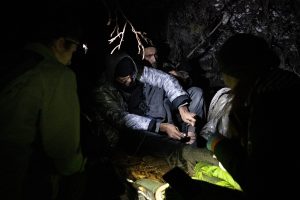
Photo : Hanna Jarzabek, 2022.
Since 14 October 2021, an amendment adopted by the Polish Parliament has legalized the turning back of migrants by border guards. This means that would-be exiles cannot even apply for asylum. Once sent back to Belarus, they are pushed back into Poland by Belarusian border guards, who force them back across the border. One migrant describes it as a “game of ping-pong”: “The Belarusians throw us into Poland, and the Polish throw us back, Belarusians in, Polish back.”(8) Some told of being stored in sheds in Belarus (in Bruzgi or Grodno) and NGOs (Grupa Granica, Human Rights Watch) report violence committed by Polish and Belarusian border guards (theft, torture, humiliation, dog attacks, rape, etc.). The government of D. Tusk, in office since December 2023, has not changed Poland’s policy.
The border and the puszcza, spaces of death and survival
On 3 September 2021, the Polish government declared a state of emergency along the entire Polish-Belarussian border. Until the state of emergency ended on 1 July 2022, only the inhabitants of the 183 municipalities in this zone and the forces of law and order were allowed to travel there. However, NGOs and the media could not (legally) enter. In this border area of the Puszcza, migrants have survived (or died) on their own, sometimes with the help of local people.
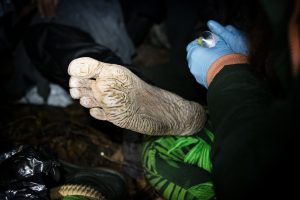
Photo : Hanna Jarzabek, 2022.
Representations of the puszcza are transformed by migration, as much from the point of view of migrants as from that of the local population or the forces of law and order. The term "Polish jungle" used by migrants and activists to refer to the puszcza captures the forest as a wild space with a high level of biodiversity but also as a place of violence linked to being turned back at the border and surviving in the forest. For the “people of the forest” (“ludzie z lasu,” in this case, the activists who come to the aid of migrants), the forest is transformed into a space where the “work” (zadanie) of humans is to survive. In this space, we find traces of objects used to assist migration, whose sole function is to help people survive (SIM cards, water bottles, sleeping bags, medicines, torches, etc.). Most of these objects left in the forest do not “identify” them and do not allow us to retrace a life path.
Thus, in the representations, the puszcza becomes, with the humanitarian crisis, a place marked by human presence. One activist described the forest in the following words: “Las patrzy na mnie ludzkimi oczami” (“The forest looks at me with human eyes”). For researcher Joanna Sarnecka, these words express the anxious discovery of a continuum between nature and culture: the puszcza becomes where activists and local populations discover violence. It becomes a place where non-human and human actors die. There is a tragic continuum between the natural and cultural worlds and a rejection of nature with the construction of the wall in the middle of the puszcza. The forest is the site of conflict between humans and/or non-humans and is an active participant in and a victim of the humanitarian crisis.

Photo : Hanna Jarzabek, 2022.
Notes:
(1) A term used in Polish and Belarusian to designate a “deep, dense forest, untouched by civilization, charged with telluric energies and rich in popular legends.” Anaïs Marin, “The Belovej primary forest: a cross-border heritage,” Regard sur l’Est, April 2013.
(2) Maciej Grześkowiak, “The ‘Guardian of the Treaties’ is No More? The European Commission and the 2021 Humanitarian Crisis on Poland–Belarus Border”, Refugee Survey Quarterly, 2023, vol. 42, pp. 81-102.
(3) Eunice Blavascunas, Benjamin Cope, “The wild border of politics: the Białowieża forest and changing ecologies of protest,” Ethnologia Polona, 2022, vol. 43, pp. 159-177.
(4) In particular, the European Habitats Directive (92/43/EEC), the European Directive on Strategic Environmental Assessment (2001/42/EC), the Bern Convention, and Polish laws on water, the environment, spatial development, and the protection of forest land.
(5) Bogdan Jaroszewicz et al., “Poland’s border wall threatens ancient forest,” Science, 2021, vol. 374, p. 1063.
(6) The Niech Żyją Foundation is a coalition of several NGOs, including Greenpeace, several Polish bird protection associations, Lex Nowa, and others.
(7) Poland and Belarus have been signatories to the Convention on the Conservation of Migratory Species of Wild Animals (Bonn Convention) since 1996 and 2003, respectively.
(8) Interview with a Syrian Kurd named Afran on 9 October 2021 in Grodno by Human Rights Watch.
Photos: © Hanna Jarzabek (the production of these photos is supported by a grant from the IJ4EU fund. The International Press Institute (IPI), the European Journalism Centre (EJC), and any other partners in the IJ4EU fund are not responsible for the content published and any use made out of it.)
* Marie Gaillard is a Master’s student in Political Science, majoring in Ecological Transitions, at the University of Paris 1 Panthéon-Sorbonne, and is also studying for a Diploma in Baltic European Civilisation and Polish at INALCO.
Link to the French version of the article
To cite this article: Marie GAILLARD (2024), “A forest at the heart of the humanitarian crisis on the Polish-Belarussian border,” Regard sur l’Est, 8 July.
